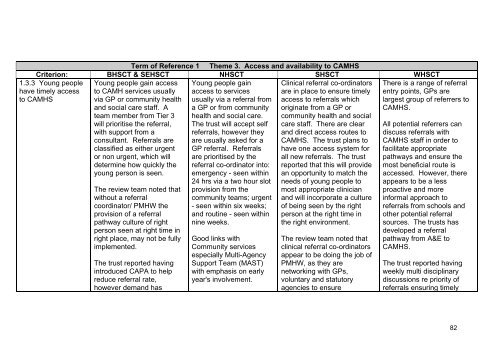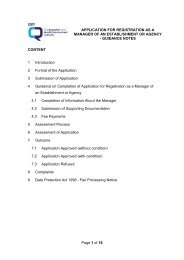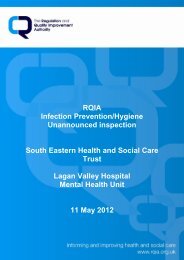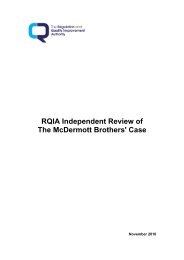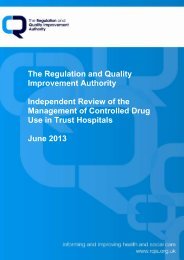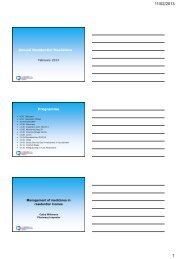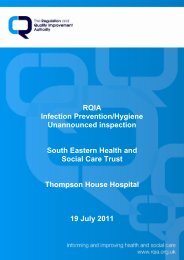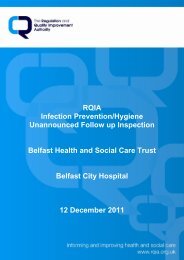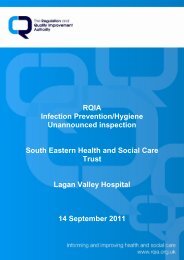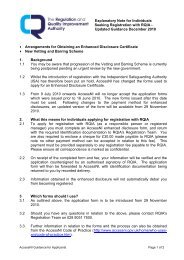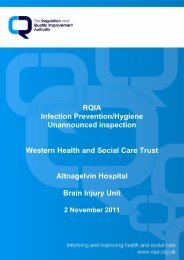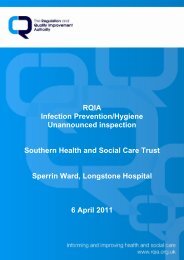RQIA Independent Review of Child and Adolescent Mental Health ...
RQIA Independent Review of Child and Adolescent Mental Health ...
RQIA Independent Review of Child and Adolescent Mental Health ...
Create successful ePaper yourself
Turn your PDF publications into a flip-book with our unique Google optimized e-Paper software.
Term <strong>of</strong> Reference 1 Theme 3. Access <strong>and</strong> availability to CAMHS<br />
Criterion: BHSCT & SEHSCT NHSCT SHSCT WHSCT<br />
Young people gain access<br />
to CAMH services usually<br />
via GP or community health<br />
<strong>and</strong> social care staff. A<br />
team member from Tier 3<br />
will prioritise the referral,<br />
with support from a<br />
consultant. Referrals are<br />
classified as either urgent<br />
or non urgent, which will<br />
determine how quickly the<br />
young person is seen.<br />
1.3.3 Young people<br />
have timely access<br />
to CAMHS<br />
The review team noted that<br />
without a referral<br />
coordinator/ PMHW the<br />
provision <strong>of</strong> a referral<br />
pathway culture <strong>of</strong> right<br />
person seen at right time in<br />
right place, may not be fully<br />
implemented.<br />
The trust reported having<br />
introduced CAPA to help<br />
reduce referral rate,<br />
however dem<strong>and</strong> has<br />
Young people gain<br />
access to services<br />
usually via a referral from<br />
a GP or from community<br />
health <strong>and</strong> social care.<br />
The trust will accept self<br />
referrals, however they<br />
are usually asked for a<br />
GP referral. Referrals<br />
are prioritised by the<br />
referral co-ordinator into:<br />
emergency - seen within<br />
24 hrs via a two hour slot<br />
provision from the<br />
community teams; urgent<br />
- seen within six weeks;<br />
<strong>and</strong> routine - seen within<br />
nine weeks.<br />
Good links with<br />
Community services<br />
especially Multi-Agency<br />
Support Team (MAST)<br />
with emphasis on early<br />
year's involvement.<br />
Clinical referral co-ordinators<br />
are in place to ensure timely<br />
access to referrals which<br />
originate from a GP or<br />
community health <strong>and</strong> social<br />
care staff. There are clear<br />
<strong>and</strong> direct access routes to<br />
CAMHS. The trust plans to<br />
have one access system for<br />
all new referrals. The trust<br />
reported that this will provide<br />
an opportunity to match the<br />
needs <strong>of</strong> young people to<br />
most appropriate clinician<br />
<strong>and</strong> will incorporate a culture<br />
<strong>of</strong> being seen by the right<br />
person at the right time in<br />
the right environment.<br />
The review team noted that<br />
clinical referral co-ordinators<br />
appear to be doing the job <strong>of</strong><br />
PMHW, as they are<br />
networking with GPs,<br />
voluntary <strong>and</strong> statutory<br />
agencies to ensure<br />
There is a range <strong>of</strong> referral<br />
entry points, GPs are<br />
largest group <strong>of</strong> referrers to<br />
CAMHS.<br />
All potential referrers can<br />
discuss referrals with<br />
CAMHS staff in order to<br />
facilitate appropriate<br />
pathways <strong>and</strong> ensure the<br />
most beneficial route is<br />
accessed. However, there<br />
appears to be a less<br />
proactive <strong>and</strong> more<br />
informal approach to<br />
referrals from schools <strong>and</strong><br />
other potential referral<br />
sources. The trusts has<br />
developed a referral<br />
pathway from A&E to<br />
CAMHS.<br />
The trust reported having<br />
weekly multi disciplinary<br />
discussions re priority <strong>of</strong><br />
referrals ensuring timely<br />
82


